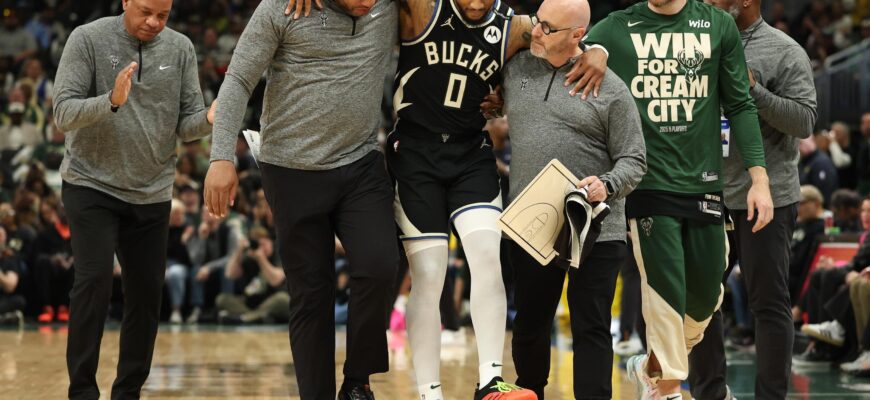During the first quarter of Sunday`s Game 4, Milwaukee Bucks guard Damian Lillard sustained an Achilles tear, a common outcome when he collapsed and instantly clutched his left lower leg and ankle. He was visibly in pain and seemed taken aback by the sudden injury.
Many athletes describe the sensation of an Achilles tendon rupture as a sudden `pop,` feeling like they were kicked in the back of the leg. The Achilles tendon connects the calf muscles to the foot. It`s crucial for movement, transferring force from the calf to push off the ground, whether walking or performing explosive actions like jumping.
At 34, Lillard is in the typical age range for elite athletes experiencing an Achilles injury. Basketball, with its frequent jumping, running, pushing off, and pivoting, is a high-risk sport for this type of injury. These actions repeatedly stress the tendon with cycles of tension, stretching, and powerful contractions.
Recently, Lillard had been out of action since March due to a deep vein thrombosis (DVT), a blood clot in a vein, often located in the calf. Initial treatment involves blood thinners and rest to prevent the clot from moving to the heart or lungs. This treatment, while necessary, usually leads to deconditioning because the athlete cannot train. Contact sports are prohibited while on blood thinners due to bleeding risks. Athletes can resume playing once the medication stops.
However, any return from an injury requiring weeks or months away from play necessitates a reconditioning phase. The duration of this gradual return varies based on the injury type, time off, activity level during recovery, sport demands, and mental readiness. The timing of the season (like the playoffs urgency) can affect the ramp-up, but detailed discussions occur between the athlete, medical team, and others about potential risks. It`s uncertain if his recent absence heightened Lillard`s Achilles injury risk, but it was probably a combination of risk factors contributing to the tendon rupture.
The focus now shifts to Lillard`s recovery and his prospects for the future, including the 2025-26 season. Surgery is imminent, followed by a carefully managed restoration of movement. Initially, this may involve a cast or removable boot, with motion strictly controlled to allow the tendon to heal. While some ankle movement is beneficial, protecting the repair from overstretching is vital, as the tendon`s elasticity is crucial. Over-lengthening would impair its function. Once healed, a more rigorous program of range of motion and strengthening will begin, leading eventually to running, jumping, and explosive drills.
Athletes usually return to play between six months and a year after this injury, with NBA players averaging about 10 months, depending on individual healing, fitness recovery, and the season schedule. Improved surgical methods have helped athletes get closer to their pre-injury form, but recovery is highly individual. Many report not fully recovering their explosive power until their second season back.
Studies on NBA players returning from Achilles tears show that while 70-80% eventually play again, most do not reach their pre-injury performance metrics, such as games played, minutes, and efficiency. This finding is partly explained by many players experiencing these injuries late in their careers when these stats might naturally be decreasing anyway.
Nevertheless, examining specific player comparisons within the NBA can provide insight into what Lillard`s path back to the court might look like.
-
Kobe Bryant: Arguably the most famous NBA player to recover from an Achilles injury, Bryant was also 34 when he was injured during the 2013 playoffs. He had surgery in April and was back on the court by December. While his return was quick, he appeared to lack his former explosiveness. His next season was cut short by shoulder surgery, and the season after that was his last in the NBA.
-
Klay Thompson: Thompson`s case is unusual because he tore his Achilles while already recovering from a torn ACL from the 2019 Finals, which made him miss the following season. Just as he was about to return for the 2020-21 season, he sustained the Achilles tear. He returned during the 2021-22 season at age 31, initially playing fewer minutes with reduced shooting efficiency. However, he rebounded the next season, increasing his minutes and setting career highs in three-pointers and rebounds.
-
Kevin Durant: Durant tore his Achilles during the 2019 Finals while with the Golden State Warriors. Interestingly, he signed a four-year contract with the Brooklyn Nets during his recovery, showing their belief in his elite return capability. Durant missed the entire 2019-20 season but came back strong the next year. Although he played only 35 games that season, largely due to other injuries, he performed like his former self. The longer, 18-month recovery period might have contributed to his successful return performance. Durant`s example suggests that NBA players in their 30s can potentially regain their pre-injury performance levels after an Achilles tear.







